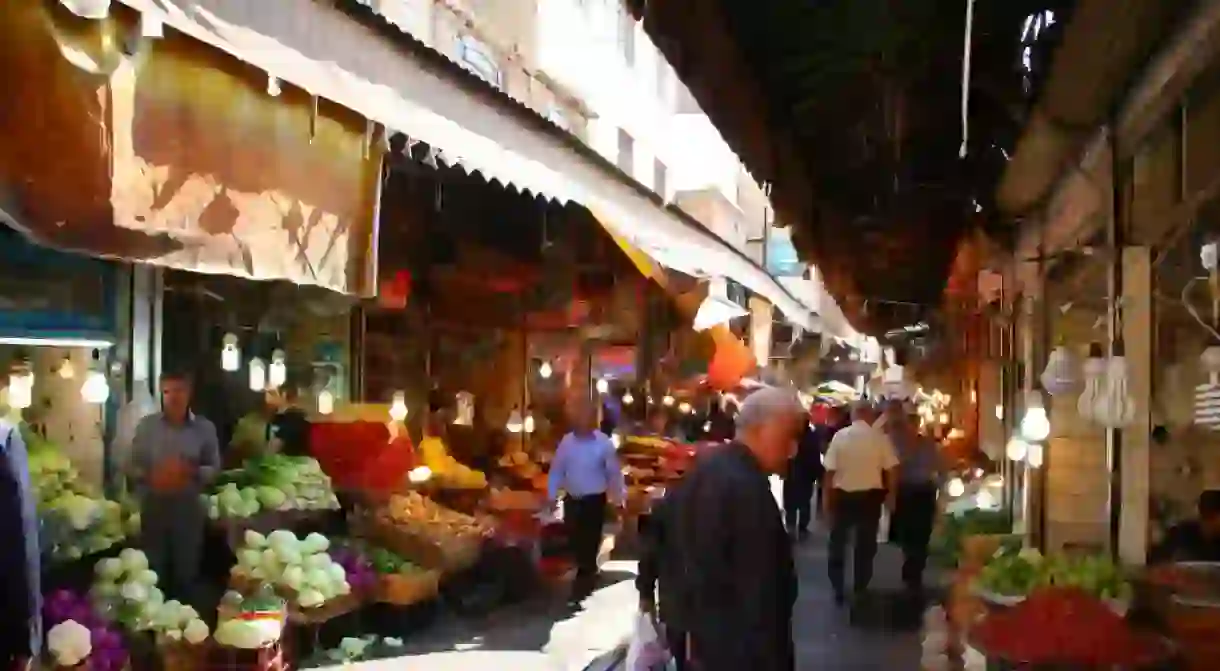The Best Restaurants In The Grand Bazaar, Tehran

No trip to Tehran is complete without an afternoon in its historic, commercial heart: the Grand Bazaar. Known as bazaar-e bozorg to locals, it is a vast labyrinth of covered shops. We pick the 10 best restaurants for a moment of calm in the chaos of Iran’s biggest mercantile hub.
Did you know – Culture Trip now does bookable, small-group trips? Pick from authentic, immersive Epic Trips, compact and action-packed Mini Trips and sparkling, expansive Sailing Trips.
Sharaf-ol-Eslami Restaurant

Located opposite the jewellery section of the Bazaar, Sharaf ol-Eslami is a reliable favourite for tourists and bazaaris alike. Offering a range of traditional Iranian food, you can enjoy a hearty portion of rice and grilled tomatoes accompanied by the stew or kebab of your choice. Its humble décor and near-constant stream of customers bear testimony to the fact that the food does the talking here. For those unaccustomed to the carbohydrate-heavy Iranian diet, it may be best to indulge here only after the majority of your bazaar-trekking is complete.
Khayyam Traditional Restaurant

Heading down Khayyam Street, just south of Khayyam Metro Station, Khayyam Traditional Restaurant is easier to find than most eateries in the Bazaar area. Just across the street from the Imamzadeh Seyyed Nasreddin Mosque, there is a tangible sense of history in this traditional-style restaurant, itself a renovated 300-year-old, former section of the mosque. The ornate tile work and domed ceilings impress as you dine on tables or while reclining on traditional Iranian carpeted eating platforms. It is more expensive than most restaurants in the area, but you can also relax with tea and shisha after eating.
Moslem Restaurant
The phenomenally busy Moslem Restaurant is probably the most popular place to eat in the whole Bazaar. Reportedly serving over 4000 customers a day, you may have to wait thirty minutes or so to be served. Located by main entrance on Panzdah-e Khordad, its no frills, in-out philosophy makes it the closest thing the bazaar has to a canteen. Its speciality is tah chin, a delicious Iranian rice cake packed with saffron, egg, yoghurt, and chicken, although they offer an excellent range of kebabs too.
Shamshiri

Shamshiri is a historic restaurant adored by locals, situated by the southeast corner of Sabz-e Meydan. With its name meaning “of the sword or skewer,” it is no surprise that Shamshiri is hailed by many as having Tehran’s best koobideh, a mincemeat kebab cooked on a skewer over burning coals. Its uninspiring decorations and plastic tablecloths are somewhat redeemed by an impressive sword that hangs on the wall.
Gol Rezaieh Café-Restaurant
Gol Rezaieh is one of the oldest café-restaurants in Tehran, established over 70 years ago. Located on Si Tir Street opposite the Glass and Ceramics Museum, it might take ten minutes in a taxi to get there from the bazaar, but it promises a different atmosphere to many other local restaurants. It has a reputation as a gathering place for intellectuals, a reputation it promotes with dozens of portraits of prominent 20th-century Iranian writers hanging from its walls. As such, the talk may be heavy but the menu is light, offering soups and salads, Iranian kotlet, or cutlets and of course, a fine selection of coffees.
Sangelaj
If the hustle and bustle of the bazaar leaves you in need of some fresh air and greenery, head up to Sangelaj restaurant in the middle of Park-e Shahr (City Park), just one block northwest of Panzdah-e Khordad metro station. Recently renovated, the restaurant’s walls are adorned with photographs and memorabilia from early 20th century Tehran. The usual array of traditional Persian dishes are on offer, as well as shisha and traditional Iranian ice-cream.
Sofrekhane Azari
While in the south of the city, it’s worth making your way down to Sofrekhane Azari, a traditional restaurant just north of the railway station that’s popular with the locals for its relaxed atmosphere and authentic food. With a reputation for some of the best abgoosht, a traditional meat and chickpea stew, in town, and regular live performances of traditional music, you will usually be well-rewarded for venturing this far south. They also serve shisha and tea, although women may sometimes be prohibited from smoking, as per the law. (South Tehran is generally more conservative, and so this law, which is flouted in many parts of the city, is more commonly upheld.)
Street Food
Iranians, quite rightly, are big fans of their own food, and as such visitors will be hard-pressed to find alternatives to the classic, rice-orientated Iranian dishes around the bazaar. If you fancy something lighter or reliably vegetarian, there is an array of street food options around the bazaar, particularly along Panzdah-e Khordad Street. Falafel sandwiches and wraps are common, or for the sweet-toothed, why not try bamieh, or Persian doughnuts – similar to Western doughnuts, but Persianized with a touch of saffron and rosewater. Milkshakes and fresh juices are also readily available.













